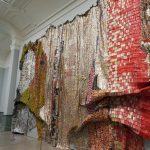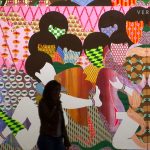Since Tate Modern opened in 2000, The Turbine Hall has hosted some great works of contemporary art. This year, the Ghanaian artist El Anatsui has been commissioned to produce an artwork for the vast industrial space. El Anatsui created a monumental 3-part sculptural installation made of thousands of metal bottle tops and fragments have been stitched together.
El Anatsui: Behind the Red Moon / Turbine Hall, Tate Modern. London (UK), October 9, 2023.
> Right-click (Mac: ctrl-click) this link to download Quicktime video file.
Press text:
Tate Modern today unveils a monumental sculptural installation created by Ghanaian artist El Anatsui. Thousands of metal bottle tops and fragments have been stitched together into three expansive abstract compositions. These undulating forms, which are the artist’s largest work to date, cut through the vast industrial space of the Turbine Hall, reflecting on the expanse of human history and the elemental power of the natural world. Each sculpture refers to Anatsui’s interest in the movement and migration of goods and people during the transatlantic slave trade. This is the eighth annual Hyundai Commission, made possible by the ongoing partnership between Tate and Hyundai Motor.
Hyundai Commission: El Anatsui: Behind the Red Moon is staged in three acts which visitors are invited to move between. The first hanging, titled ‘The Red Moon’, resembles the majestic sail of a ship billowing out in the wind, announcing the beginning of a journey across the Atlantic Ocean. Red liquor bottle tops form the outline of a red moon, or ‘blood moon’, as it appears during a lunar eclipse. The second sculpture, ‘The World’, is composed of many individual layers that evoke human figures suspended in a restless state. The ethereal appearance of these figures is achieved using thin bottle-top seals wired together to create a net-like material. When viewed from a particular vantage point, these scattered shapes come together into a single circular form of the Earth. In Anatsui’s final hanging, ‘The Wall’, a monumental black sheet of metal cloth stretches from floor to ceiling. At its base, pools of bottle tops rise from the ground in the form of crashing waves and rocky peaks. Behind its black surface, a delicate structure of shimmering silver is revealed, covered in a mosaic of multi-coloured pieces. This combination of lines and waves, blackness and technicolour, echoes the collision of global cultures and hybrid identities that Anatsui invites us to consider throughout his work.
Viewing all three hangings together from afar reveals a landscape of symbols: the moon, the sail, the wave, the earth, and the wall. Up close, the logos on the bottle tops speak of the material’s social histories, referencing a present-day industry built on colonial trade routes. The past and present of Africa and Europe converge into symphonic sculptural forms that hang in the air and appear to float across the space. Through the poetic use of material as metaphor, Hyundai Commission: El Anatsui: Behind the Red Moon explores elemental forces interwoven with human histories of power, oppression, dispersion and survival.
El Anatsui was born in Anyako, Ghana in 1944 and has predominantly lived and worked in Nigeria. His highly experimental approach to sculpture embraces a wide range of forms and materials, including wood, ceramics and found objects. He has experimented with liquor bottle tops since the late 1990s and continues to push the medium’s boundaries in novel ways. Aided in his studio by dozens of assistants, Anatsui and his team work together to stitch and assemble his metallic hangings. Embodying Anatsui’s idea of the ‘non-fixed form’, the hangings fold easily in order to travel and appear different each time they are installed. Interested in the changing histories of the objects he repurposes, Anatsui fuses specific local aesthetic traditions with the global history of abstraction. His choice of materials embodies ideas that have shaped his career over several decades, including the evolution of human civilisation, African decolonisation movements, histories of migration and encounter, and life’s existential journeys.
Since Tate Modern opened in 2000, the Turbine Hall has hosted some of the world’s most memorable and acclaimed works of contemporary art, reaching an audience of millions each year. The way artists have interpreted this vast industrial space has revolutionised public perceptions of contemporary art in the twenty-first century. The annual Hyundai Commission gives artists an opportunity to create new work for this unique context. The Hyundai Commission is made possible by the long-term partnership between Tate and Hyundai Motor, confirmed until 2026 as part of the longest initial commitment from a corporate partner in Tate’s history.






